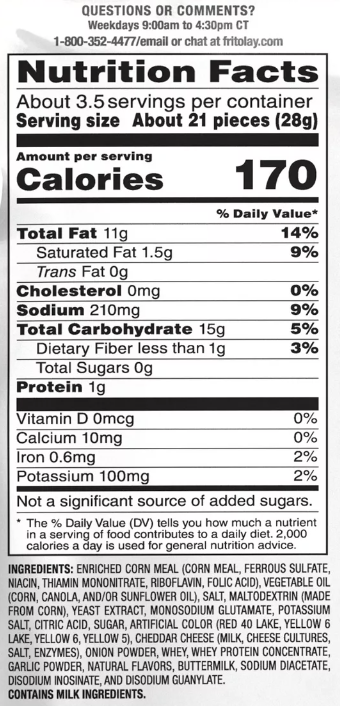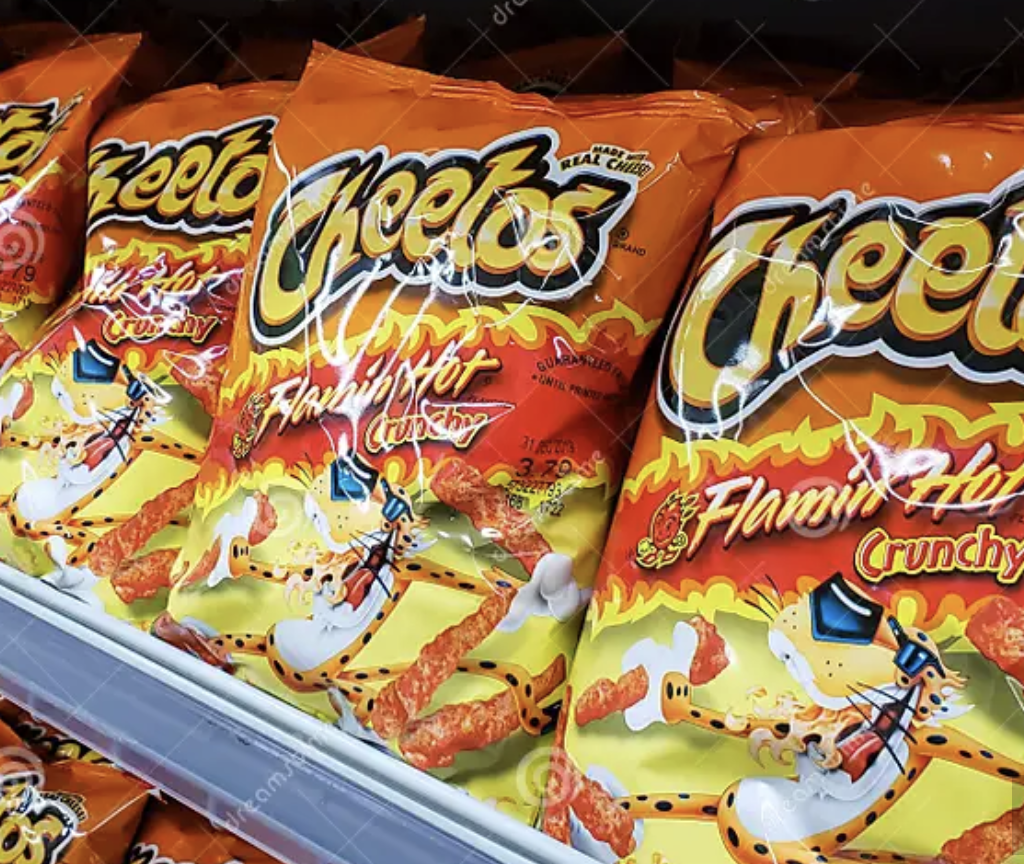The first thing we have to do in order to eat healthier is to start reading labels.
Steps for reading food labels:
- Start by looking at the serving size. If you eat more than the “serving size” then you will have to do some math.
- A lot of the times, we are eating MORE than one serving size. Let’s be realistic about the portions when you look at the label so that you know what you are actually eating.
- If the package says “about 2 servings per container” but you are going to eat everything in the container, then you will have to multiply the listed amount by two.
- For example, let’s look at the label for my favorite guilty pleasure; Hot Cheetos.
- First look at the serving size. It says there are 3.5 servings per container (this is a 3 1/4 oz bag). The label tells me one serving size is 21 pieces. But I will eat the whole bag because I have no self-control with this poison. Therefore, it means I will have to multiply the nutrition facts by 3.5, to find out what I am consuming.
Macronutrients In Hot Cheetos

- Let’s find out what I am consuming in a 3.25oz bag of my favorite chips.
- Calories 170 x 3.5 = 595 calories.
- If I was eating 2000cal/day this bag of cheetos would represent more than a third of my daily caloric intake 😵
- Fat: 11g x 3.5 = 38.5g of fat.
- This is a lot of fat. That is more than half of the recommended daily intake if I were on a 2000 cal diet.
- Sodium: 210mg x 3.5 = 735mg sodium.
- Adults actually only need 1500mg sodium daily. If you have hypertension the recommendation is to limit sodium intake to no more than 2300mg per day.
- Calories 170 x 3.5 = 595 calories.
- Carbohydrates 15g x 3.5 = 52.5g carb.
- Not only is that a lot of carbs, but these are processed refined carbs -the worst kind.
- Fiber: Less than 1g
- Most of us are not eating enough fiber in our diet and processed snacks like chips are the the place to get our fiber from.
- Protein: 1g x 3.5 = 3.5g protein
- Not a significant source of protein
- Minerals: A little bit of calcium (10mg) and iron (0.6mg).
Ingredients in Hot Cheetos
- “Enriched” corn meal: When you see the word “enriched” that means that during processing they stripped the original food product (corn meal) of its nutrients but then added some nutrients back (iron, niacin, thiamin, riboflavin, folic acid in this case).
- Vegetable oil: Vegetable and seed oils sound like they should be healthy because they originate from vegetables. However, the process by which vegetable oils are made requires a lot of refining, bleaching and stripping away nutrients. At high temperatures there oils generate dangerous oxidative radicals which cause inflammation and tissue damage.
- Therefore, it’s best to avoid these types of oils and look for snacks made with olive oil or avocado oil.
- Maltodextrin: Highly processed carbohydrate that spikes the blood sugar. Spikes of blood sugar are what eventually lead to insulin resistance which is the first event that occurs in the development of type 2 diabetes.
- Monosodium glutamate (MSG) is a flavoring that dissociates into sodium and glutamate (an amino acid) in the blood. Once absorbed into the bloodstream, glutamate can act as an excitatory neurotransmitter in the brain. The stimulation of these receptors contributes to the perception of the savory taste associated with MSG. However, excessive consumption of MSG is addicting and can lead to an excessive activation of glutamate receptors, potentially causing excitotoxicity, a process in which overstimulation of neurons leads to cell damage or death.
- Artificial dyes red40, yellow6, and yellow5. The use of artificial dyes has increased over 500% in the past 50 years. Unfortunately, most of it is consumed by children in the form of snacks, cereals, beverages and candy. These dyes are made from petroleum and banned in certain European countries. They have been linked to autism and ADHD in children. See the news clip below for more details.
As shown in the video, large snack manufacturing companies can produce snacks without food dye additives, as they do for products sold in Europe. However, they choose not to do so in our country. Therefore, we too have the choice to opt out of purchasing these products.
Hot Cheetos Are an Unhealthy Snack
To summarize, while Hot Cheetos are delicious and are a staple in the Latinx snack repertoire, the truth of the matter is that they are not good for us. In fact, they are toxic. I recently saw the Flaming hot movie, and while I love Eva Longoria and I am all about the telling of a heartwarming and inspiring true story that celebrates our culture, I cannot deny the facts when it comes to how the company has chosen to make this Latinx favored snack: It is made in a way that is unhealthy.
The flavors of the chips that represent the Mexican heritage is what we love about the product (not shown on the ingredients list), but the ingredients that are used to make the chips (the highly refined carbohydrate), what they add to it to make it sell/become addicting (MSG & toxic food dyes), and the chemicals they add to make it last longer on grocery shelves (the ingredients listed at the end that you probably can’t pronounce) are what make the chips a nutrient deficient snack high in calories, rich in fat, carbs, and sodium that is harmful to people with diabetes, hypertension or any features of the metabolic syndrome.
Useful Links About Excess Sugars
- American Heart Association: The Skinny on Fats
- Healthline: Are Takis Bad For You (a similar guilty pleasure)


